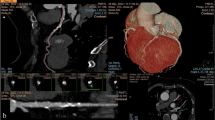Abstract
Measurements related to coronary artery calcification (CAC) offer significant predictive value for coronary artery disease (CAD). In current medical practice CAC scoring is a labor-intensive task. The objective of this paper is the development and evaluation of a family of coronary artery region (CAR) models applied to the detection of CACs in coronary artery zones and sections. Thirty patients underwent non-contrast electron-beam computed tomography scanning. Coronary artery trajectory points as presented in the University of Houston heart-centered coordinate system were utilized to construct the CAR models which automatically detect coronary artery zones and sections. On a per-patient and per-zone basis the proposed CAR models detected CACs with a sensitivity, specificity and accuracy of 85.56 (±15.80)%, 93.54 (±1.98)%, and 85.27 (±14.67)%, respectively while the corresponding values in the zones and segments based case were 77.94 (±7.78)%, 96.57 (±4.90)%, and 73.58 (±8.96)%, respectively. The results of this study suggest that the family of CAR models provide an effective method to detect different regions of the coronaries. Further, the CAR classifiers are able to detect CACs with a mean sensitivity and specificity of 86.33 and 93.78%, respectively.


Similar content being viewed by others
Notes
See "Methods" Section for an exact definition of zones and sections.
Train CAR classifier using all patient data except for one data set and test on the left-out data set. Repeat for all patients and report the averaged performance.
References
National Institutes of Health (2007) National heart lung and blood institute, disease statistics
Naghavi M, Libby P, Falk E, Casscells S, Litovsky S, Rumberger J, Badimon J, Stefanadis C, Moreno P, Pasterkamp G, Fayad Z, Stone P, Waxman S, Raggi P, Madjid M, Zarrabi A, Burke A, Yuan C, Fitzgerald P, Siscovick D, de Korte C, Aikawa M, Airaksinen K, Assmann G, Becker C, Chesebro J, Farb A, Galis Z, Jackson C, Jang I, Koenig W, Lodder R, March K, Demirovic J, Navab M, Priori S, Rekhter M, Bahr R, Grundy S, Mehran R, Colombo A, Boerwinkle E, Ballantyne C, Insull W, Schwartz R, Vogel R, Serruys P, Hansson G, Faxon D, Kaul S, Drexler H, Greenland P, Muller J, Virmani R, Ridker P, Zipes D, Shah P, Willerson J (2003) From vulnerable plaque to vulnerable patient: Aa call for new definitions and risk assessment strategies: part II. Circulation 108(15):1772–1778
Agatston A, Janowitz W, Hildner F, Zusmer N, Viamonte MJ, Detrano R (1990) Quantification of coronary artery calcium using ultrafast computed tomography. J Am Coll Cardiol 15(4):827–32
Carr JJ, Nelson JC, Wong ND, McNitt-Gray M, Arad Y, Jacobs J, Sidney DRS, Bild DE, Williams OD, Detrano RC (2005) Calcified coronary artery plaque measurement with cardiac CT in population-based studies: standardized protocol of Multi-ethnic study of atherosclerosis (MESA) and Coronary artery risk development in young adults (CARDIA) study. Radiology 234(1):35–43
Brown ER, Kronmal RA, Bluemke DA, Guerci AD, Carr JJ, Goldin J, Detrano R (2008) Coronary calcium coverage score: determination, correlates, and predictive accuracy in the multi-ethnic study of atherosclerosis. Radiology 247(3):669–75
Kurkure U, Chittajallu D, Brunner G, Yalamanchili R, Kakadiaris I (2008) Detection of coronary calcifications using supervised hierarchical classification. In: Proceedings of 2nd MICCAI workshop on computer vision for intravascular and intracardiac imaging, New York, NY, Sep. 10 2008
Goo HW, Park IS, Ko JK, Kim YH, Seo DM, Yun TJ, Park JJ, Yoon CH (2003) CT of congenital heart disease: normal anatomy and typical pathologic conditions. Radiographics 23:147–65
Aubry P, Joudinaud T, Hyafil F (2008) Anomalous origin of coronary arteries in adults. Ann Cardiol Angeiol (Paris) 57(6):327–334
Yang Y, Stillman A, Tannenbaum A, Giddens D (2007) Automatic segmentation of coronary arteries using bayesian driven implicit surfaces. In: Proceedings of IEEE international symposium on biomedical imaging: from nano to macro, Washington, DC, Apr. 2007, pp 189–192
Banh D, Kyprianou I, Paquerault S, Myers K (2007) Morphology-based three-dimensional segmentation of coronary artery tree from CTA scans in medical imaging 2007: image processing, vol. 6512, presented at the Society of photo-optical instrumentation engineers (SPIE) conference, pp 65–122
Kondos GT, Hoff JA, Sevrukov A, Daviglus ML, Garside DB, Devries SS, Chomka EV, Liu K (2003) Electron-beam tomography coronary artery calcium and cardiac events: a 37-month follow-up of 5635 initially asymptomatic low- to intermediate-risk adults. Circulation 107(20):2571–2576
Greenland P, LaBree L, Azen SP, Doherty TM, Detrano RC (2004) Coronary artery calcium score combined with Framingham score for risk prediction in asymptomatic individuals. JAMA 291(2):210–5
Bild DE, Detrano R, Peterson D, Guerci A, Liu K, Shahar E, Ouyang P, Jackson S, Saad MF (2005) Ethnic differences in coronary calcification: the Multi-Ethnic Study of Atherosclerosis (MESA). Circulation 111(10):1313–20
Brunner G, Chittajallu D, Kurkure U, Kakadiaris I (2008) A heart-centered coordinate system for the detection of coronary artery zones in non-contrast computed tomography data. In: Proceedings of 2nd MICCAI workshop on computer vision for intravascular and intracardiac imaging, New York, NY, Sep. 10 2008
Xiao J (2007) A new coordinate system for rodent brain and variability in the brain weights and dimensions of different ages in the naked mole-rat. J Neurosci Methods 162(1–2):162–70
Vapnik V (1995) The nature of statistical learning theory. Springer Verlag, Berlin
WG Austen, Edwards JE, Frye RL, Gensini GG, Gott VL, Griffith LS, McGoon DC, Murphy ML, Roe BB (1975) A reporting system on patients evaluated for coronary artery disease. Report of the ad hoc committee for grading of coronary artery disease, council on cardiovascular surgery, american heart association. Circulation 51(4):5–40
Acknowledgments
This work was supported in part by the Biomedical discovery Training Program of the W.M. Keck Center for Interdisciplinary Bioscience Training of the Gulf Coast Consortia (NIH Grant No. 1 T90 DA022885 and 1 R90 Da023418), and in part by NSF Grants IIS-0431144, and CNS-0521527.
Author information
Authors and Affiliations
Corresponding author
Rights and permissions
About this article
Cite this article
Brunner, G., Chittajallu, D.R., Kurkure, U. et al. Toward the automatic detection of coronary artery calcification in non-contrast computed tomography data. Int J Cardiovasc Imaging 26, 829–838 (2010). https://doi.org/10.1007/s10554-010-9608-1
Received:
Accepted:
Published:
Issue Date:
DOI: https://doi.org/10.1007/s10554-010-9608-1




